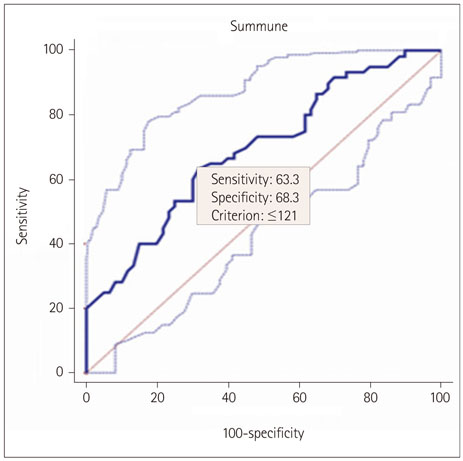J Clin Neurol.
2016 Apr;12(2):166-171. 10.3988/jcn.2016.12.2.166.
Motor-Unit Number Estimation Is Sensitive in Detecting Motor Nerve Involvement in Patients with Carpal Tunnel Syndrome
- Affiliations
-
- 1Department of Neurology, Marmara University Pendik Education and Research Hospital, Istanbul, Turkey. kayihanu@yahoo.com
- 2Department of Neurology, Uskudar University, NPIstanbul Neuropsychiatry Hospital, Istanbul, Turkey.
- KMID: 2354136
- DOI: http://doi.org/10.3988/jcn.2016.12.2.166
Abstract
- BACKGROUND AND PURPOSE
We compared the motor-unit number estimation (MUNE) findings in patients who presented with signs and/or findings associated with carpal tunnel syndrome (CTS) and healthy controls, with the aim of determining if motor-unit loss occurs during the clinically silent period and if there is a correlation between clinical and MUNE findings in CTS patients.
METHODS
The study investigated 60 hands of 35 patients with clinical CTS and 60 hands of 34 healthy controls. Routine median and ulnar nerve conduction studies and MUNE analysis according to the multipoint stimulation method were performed.
RESULTS
The most common electrophysiological abnormality was reduced conduction velocity in the median sensory nerve (100% of the hands). The MUNE value was significantly lower for the patient group than for the control group (p=0.0001). ROC analysis showed that a MUNE value of 121 was the optimal cutoff for differentiating between patients and controls, with a sensitivity of 63.3% and a specificity of 68.3%. MUNE values were lower in patients with complaints of numbness, pain, and weakness in the median nerve territory (p<0.05, for all comparisons), and lower in patients with hypoesthesia than in patients with normal neurological findings (p=0.023).
CONCLUSIONS
The MUNE technique is sensitive in detecting motor nerve involvement in CTS patients who present with sensorial findings, and it may be useful in detecting the loss of motor units during the early stages of CTS. Larger-scale prospective clinical trials assessing the effect of early intervention on the outcome of these patients would help in confirming the possible benefit of detecting subclinical motor-unit loss in CTS.
MeSH Terms
Figure
Reference
-
1. Katz JN, Simmons BP. Clinical practice. Carpal tunnel syndrome. N Engl J Med. 2002; 346:1807–1812.2. Omer GE Jr. Median nerve compression at the wrist. Hand Clin. 1992; 8:317–324.
Article3. Stevens JC. AAEM minimonograph #26: the electrodiagnosis of carpal tunnel syndrome. American Association of Electrodiagnostic Medicine. Muscle Nerve. 1997; 20:1477–1486.
Article4. Jablecki CK, Andary MT, Floeter MK, Miller RG, Quartly CA, Vennix MJ, et al. Practice parameter: electrodiagnostic studies in carpal tunnel syndrome. Report of the American Association of Electrodiagnostic Medicine, American Academy of Neurology, and the American Academy of Physical Medicine and Rehabilitation. Neurology. 2002; 58:1589–1592.
Article5. McComas AJ, Fawcett PR, Campbell MJ, Sica RE. Electrophysiological estimation of the number of motor units within a human muscle. J Neurol Neurosurg Psychiatry. 1971; 34:121–131.
Article6. Brown WF. Thenar motor unit count estimates in the carpal tunnel syndrome. J Neurol Neurosurg Psychiatry. 1973; 36:194–198.7. Cuturic M, Palliyath S. Motor unit number estimate (MUNE) testing in male patients with mild to moderate carpal tunnel syndrome. Electromyogr Clin Neurophysiol. 2000; 40:67–72.8. Koç F, Yerdelen D, Sarica Y, Sertdemir Y. Motor unit number estimation in cases with Carpal Tunnel Syndrome. Int J Neurosci. 2006; 116:1263–1270.
Article9. Bayrak IK, Bayrak AO, Tilki HE, Nural MS, Sunter T. Ultrasonography in carpal tunnel syndrome: comparison with electrophysiological stage and motor unit number estimate. Muscle Nerve. 2007; 35:344–348.
Article10. Sohn MK, Jee SJ, Hwang SL, Kim YJ, Shin HD. Motor unit number estimation and motor unit action potential analysis in carpal tunnel syndrome. Ann Rehabil Med. 2011; 35:816–825.
Article11. Bromberg MB. Updating motor unit number estimation (MUNE). Clin Neurophysiol. 2007; 118:1–8.
Article12. Padua L, LoMonaco M, Gregori B, Valente EM, Padua R, Tonali P. Neurophysiological classification and sensitivity in 500 carpal tunnel syndrome hands. Acta Neurol Scand. 1997; 96:211–217.
Article13. Stålberg E, Falck B. Clinical motor nerve conduction studies. Methods Clin Neurophysiol. 1993; 4:61–80.14. Falck B, Stålberg E, Bischoff C. Sensory nerve conduction studies with surface electrodes. Methods Clin Neurophysiol. 1994; 5:1–20.15. Jablecki CK, Andary MT, So YT, Wilkins DE, Williams FH. Literature review of the usefulness of nerve conduction studies and electromyography for the evaluation of patients with carpal tunnel syndrome. AAEM Quality Assurance Committee. Muscle Nerve. 1993; 16:1392–1414.
Article16. Kadrie HA, Yates SK, Milner-Brown HS, Brown WF. Multiple point electrical stimulation of ulnar and median nerves. J Neurol Neurosurg Psychiatry. 1976; 39:973–985.
Article17. Doherty TJ, Stashuk DW, Brown WF. Multiple point stimulation and F-response MUNE techniques. Suppl Clin Neurophysiol. 2003; 55:29–40.
Article18. Daube JR. Motor unit number estimates--from A to Z. J Neurol Sci. 2006; 242:23–35.
Article19. Bromberg MB. Motor unit number estimation: new techniques and new uses. Suppl Clin Neurophysiol. 2004; 57:120–136.20. Gooch CL, Doherty TJ, Chan KM, Bromberg MB, Lewis RA, Stashuk DW, et al. Motor unit number estimation: a technology and literature review. Muscle Nerve. 2014; 50:884–893.
Article
- Full Text Links
- Actions
-
Cited
- CITED
-
- Close
- Share
- Similar articles
-
- Nerve Conduction Studies after Surgical Release of Carpal Tunnel Syndrome
- A Case of Strong Palm Compression-Induced Thenar Motor Neuropathy
- Median Nerve Block for Treatment of Carpal Tunnel Syndrome: Report of 5 cases
- Carpal Tunnel Syndrome with Recurrent Motor Branch Entrapment: A Case Report
- Motor Unit Number Estimation of Normal Thenar Muscle


